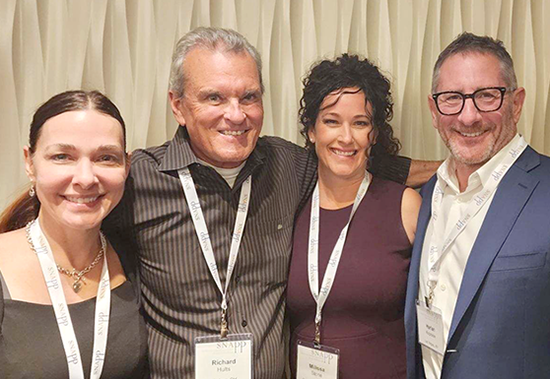|
|
|
|
|
|
|
|
 Board members (l-r): Lisa Hamilton, OD; Richard Hults, OD; Milissa Stone; and Ken Kopolow, OD Board members (l-r): Lisa Hamilton, OD; Richard Hults, OD; Milissa Stone; and Ken Kopolow, OD
|
|
|
By the SNAPP Board
Thanksgiving seems like a perfectly placed holiday. Here it is, before we rush headlong into the busy season and crunch the 4Q and annual numbers for 2024. It offers us a time to reflect on what is good before we scurry off to the next task on our to-do lists.
|
|
|
|
|
Your gratitude list may look a lot like ours, but we encourage you to take a moment to reflect on what you’d like to add to it.
We are grateful that
• We work in a profession that truly helps people and changes lives;
• Our patients trust us and have built relationships with us;
• As eye care professionals, we are part of the continuity of care in our communities;
• Our teams are dedicated and supportive, all working together to provide exceptional care;
• The technology advances of recent years—from diagnostic equipment to products we prescribe—have allowed us to do more for patients;
• Work-life balance exists, allowing us to spend time with family and friends;
• We are in the SNAPP network, where doctors and Licensed Operators share their ideas and encouragement so freely;
• Our vendor community generously supports us as an organization and as individual practitioners;
• SNAPP is in a position to be able to provide stellar continuing education and practice management education to our members;
• And the future looks bright.
Finally, we are grateful for each of you who help make SNAPP such a rewarding program for all of us.
|
|
|
|
|
|
|
Small Gestures, Big Impact: How Custom Products Build Patient Loyalty
|
|
|
 Andrew Ladochi Andrew Ladochi |
|
|
“Your last impression is your most memorable one,” says Andrew Ladochi, Licensed Operator at a Pearle Vision in Chicago, Illinois, in a north side community known as Andersonville. He understands the value of branding and the subtle impact of memorable touchpoints in patient interactions.
|
|
|
|
|
He has developed a small but meaningful tradition of giving away custom products that ensure patients don’t forget the practice. The custom-branded lens spray and complimentary cases serve as simple yet effective tools to keep Pearle Vision in the minds of customers long after their visit.
The strategy has been a hit with patients, and Ladochi sees it reflected in the numbers. “We’ve been doing it for three years now, and people have come back just to get the spray bottle,” he says. “It’s a great opportunity to remind them of our services, and we often convert those visits into sales.” While some might see these items as minor giveaways, Ladochi views them as investments in long-term patient retention, with costs of less than $1 per 1-ounce spray bottle and 66 cents for a branded complimentary case. In the larger picture, those small costs are more than worth it to keep patients connected.
As a relatively new location that opened in March 2019 without an established patient base, Ladochi knew that building trust and visibility would be crucial. Google reviews quickly became an essential tool. “We have a 4.9-star rating with over 270 reviews, and our doctor, Zachary Weekes, OD, has 600 reviews and maintains a perfect 5-star rating,” he shares proudly. That digital presence helped propel the practice to seeing a full day of patients, even during the height of the pandemic, when they were booked out two months in advance.
Ladochi’s business philosophy revolves around leveraging small, thoughtful touches to create strong relationships with patients, while also streamlining the practice’s operations. For example, he recently outsourced billing and reconciliation to HELIX RCM. “I thought I was great at it, but I was always behind,” he admits. “Now, they’re on top of it, and I have more free time to focus on growing the business.”
This growth has led to the decision to expand with a remote doctor option using DigitalOptometrics, set to go live this month, allowing the practice to keep up with increasing demand for exams. As Ladochi sees it, every detail matters in keeping Pearle Vision front and center in patients’ minds, ensuring that the last impression is always a memorable one.
|
|
|
|
|
|
|
|
|
 Mick Kling, OD Mick Kling, OD
|
|
|
At the SNAPP meeting in Las Vegas, Mick Kling, OD, spoke about the importance of a genuine smile—both to the person who is being greeted and the greeter.
For someone walking into an office, the greeter’s body language says a lot. A genuine smile reaches the eyes and is not just an upturn of the lips. Patients and customers can tell if the smile is genuine or plastered on.
|
|
|
|
|
Dr. Kling noted that other body language “tells” can help someone feel more comfortable.
Raising your eyebrows signifies recognition.
A more open-armed position is more welcoming than arms crossed. “It shows a vulnerability that builds trust,” he says.
The person doing the smiling also benefits. Smiling can reduce cortisol levels. Cortisol is the stress hormone. Smiling can also release endorphins or mood boosters. Plus, smiling in the workplace can be contagious.
“Good leaders create a circle of safety,” he says, with empathy and kindness. “There’s a feeling of belonging where people feel safe to express concerns.”
Compare that environment to an autocratic leadership style, where rewards and threats drive action and employees feel prolonged anxiety.
|
|
|
Billing Tip of the Month from HELIX |
|
|
|
|
The Importance of Specificity in the Medical Record
|
|
|
|
One topic that pops up time and time again in medical record reviews is the use of non-descriptive terminology by clinicians. These occurrences can create challenges in an “unfriendly” audit, whether payor or legal in nature.
A frequently encountered example relates to glaucoma management. Consider the difference between a reason for visit of “IOP check” versus “3-month IOP eval for POAG OU as directed.” Both make sense internally, but the latter provides a level of specificity that would reduce the unnecessary risk of third-party questions.
Similarly, it’s common for providers to briefly address a diagnosis with “Monitor” without including simple yet significant details related to when and why. Instead, try a more descriptive reference like “Monitor for progression in 6 months.” The additional detail provides significantly more clarity.
A final example of where specificity can be helpful relates to return-to-clinic plans. In such plans, it’s common to see documentation such as “Return annually” or “Repeat test yearly.” Importantly, these approaches have the potential to be viewed by third parties as “standing orders” or events that are going to take place without regard for the patient’s status, which is generally discouraged. Instead, third parties prefer to see the patient’s needs dictating what tests are performed and when. Therefore, it’s ideal to specify the precise time frame for the next test or visit, such as “Return in 1 year for comp exam,” or “Repeat OCT in 6 months.”
We hope that what stands out in each of these examples is that the added time required to include this level of specificity is not great. By including references to “when” and “why” whenever possible, medical records become much easier to interpret for anyone, leading to enhanced continuity of care and reimbursement protection.
Reach out to the HELIX team with any billing questions you have. We might have the solution for you.

|
|
|
|
|
|
|
Writing an Effective Job Description
|
|
|
|
Q: What should we include in a job description?
A: Accurate and carefully crafted job descriptions are essential for attracting and keeping new employees, setting clear performance expectations and serving as a critical line of defense in many types of employment litigation.
As with the job posting, the interview process is an opportunity to build excitement for the role, but also to eliminate candidates who looked qualified on paper but don’t truly possess the capabilities to do the job to your satisfaction.
Effective job descriptions include the following:
• Job title: Create a title that accurately reflects the position. Avoid cutesy terms like “ninja” or “guru.” If applicable, use the title to indicate where the position fits in a career ladder (e.g., a senior manager).
• Exemption status: Indicate whether the role is exempt from minimum wage and/or overtime.
• Position summary: Provide a brief, high-level overview of the position’s purpose and duties. It should be clear and concise.
• Essential functions: List the three to five most critical responsibilities and tasks, starting with the most important task or the one to which the employee will devote the largest share of their time.
• Qualifications: Identify the knowledge, skills, abilities and other characteristics that an individual must have to perform the job duties.
• Supervision: Indicate how this position is supervised or to whom the person in this position will report.
• Work environment: Give an idea of the nature of the location (e.g., remote or corporate) and working conditions. Be sure to include any physical requirements of the job, noise levels and/or temperature.
This Q&A does not constitute legal advice and does not address state or local law.
|
|
|
|
|
Learning From Someone Else’s Bad Experience |
|
|
|
A 23-year-old Texas woman who contracted Acanthamoeba keratitis while swimming in her contact lenses has shared her story on Today. She said she removes her 30-day lenses every night and cleans them as directed. But she also said that she had never heard that she wasn’t supposed to swim with her contact lenses in. Read more. |
|
|
|
Alcohol Consumption, Which Rose After Pandemic, Stays High
|
|
|
|
A Medscape commentary shows that alcohol consumption has remained high since the pandemic. Author F. Perry Wilson, MSCE, MD, says, “The information we have from this study is purely descriptive. It tells us that people are drinking more since the pandemic. It doesn’t tell us why, or the impact that this excess drinking will have on subsequent health outcomes.” Read his whole commentary here. |
|
|
|
Visual “Clutter” Affects the Brain |
|
|
|
In a new study, Yale researchers show that visual clutter—objects or people within the field of vision but not the main focus—alters how information flows in the brain, as does the precise location of that clutter within the wider field of vision. Researchers compared visual clutter to the telephone game or phone tree. “The location of visual clutter didn’t change the order of the phone tree, but it did change how well the message was relayed person to person.” The study was published in the October issue of the journal Neuron. Read the summary here. |
|
|
|
|
Photo credits—Getty images: grateful: ODonnell Photograf; idea: justinmedia; smiles: monkeybusinessimages; medical record: The Good Brigade; hiring: filo; contact lens: Alessandro de Leo; drinks: Romolo Tavani; clutter: Natalia Lebedinskaia
|
|
|
|
|
|
|







